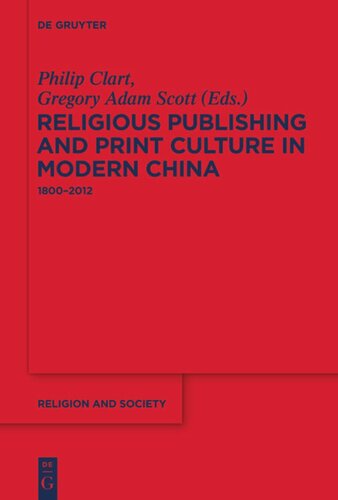

Most ebook files are in PDF format, so you can easily read them using various software such as Foxit Reader or directly on the Google Chrome browser.
Some ebook files are released by publishers in other formats such as .awz, .mobi, .epub, .fb2, etc. You may need to install specific software to read these formats on mobile/PC, such as Calibre.
Please read the tutorial at this link: https://ebookbell.com/faq
We offer FREE conversion to the popular formats you request; however, this may take some time. Therefore, right after payment, please email us, and we will try to provide the service as quickly as possible.
For some exceptional file formats or broken links (if any), please refrain from opening any disputes. Instead, email us first, and we will try to assist within a maximum of 6 hours.
EbookBell Team

0.0
0 reviewsScholarly interest in print culture and in the study of religion in modern China has increased in recent years, propelled by maturing approaches to the study of cultural history and by a growing recognition that both were important elements of China's recent past. The influence of China in the contemporary world continues to expand, and with it has come an urgent need to understand the processes by which its modern history was made. Issues of religious freedom and of religion's influence on the public sphere continue to be contentious but important subjects of scholarly work, and the role of print and textual media has not dimmed with the advent of electronic communication. This book, Religious Publishing and Print Culture in Modern China1800-2012, speaks to these contemporary and historical issues by bringing to light the important and abiding connections between religious development and modern print culture in China. Bringing together these two subjects has a great deal of potential for producing insights that will appeal to scholars working in a range of fields, from media studies to social historians.
Each chapter demonstrates how focusing on the role of publishing among religious groups in modern China generates new insights and raises new questions. They examine how religious actors understood the role of printed texts in religion, dealt with issues of translation and exegesis, produced print media that heralded social and ideological changes, and expressed new self-understandings in their published works. They also address the impact of new technologies, such as mechanized movable type and lithographic presses, in the production and meaning of religious texts. Finally, the chapters identify where religious print culture crossed confessional lines, connecting religious traditions through links of shared textual genres, commercial publishing companies, and the contributions of individual editors and authors. This book thus demonstrates how, in embracing modern print media and building upon their longstanding traditional print cultures, Christian, Buddhist, Daoist, and popular religious groups were developed and defined in modern China. While the chapter authors are specialists in religious traditions, they have made use of recent studies into publishing and print culture, and like many of the subjects of their research, are able to make connections across religious boundaries and link together seemingly discrete traditions.